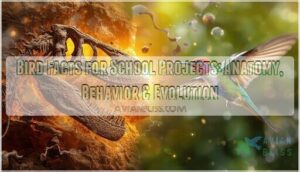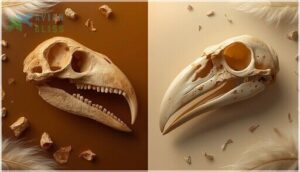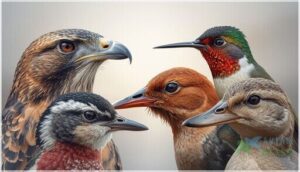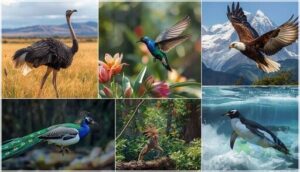This site is supported by our readers. We may earn a commission, at no cost to you, if you purchase through links.
Your teacher just assigned a project about birds, and you need facts that will impress your classmates. Here’s something cool to start with: birds are living dinosaurs with hollow bones that make their skeletons weigh less than their feathers. Scientists discovered that chickens share DNA with T-rex, proving that these feathered creatures didn’t just appear out of nowhere.
From hummingbirds smaller than your thumb to ostriches taller than your dad, birds show incredible variety in how they look, act, and survive. Whether you’re researching bird facts for school projects or just curious about nature, understanding these animals means learning about evolution, anatomy, and behaviors that scientists still study today.
Get ready to discover why flamingos turn pink, how owls spin their heads almost all the way around, and which birds stay married for life.
Table Of Contents
- Key Takeaways
- Amazing Bird Anatomy and Physical Features
- Fascinating Bird Behaviors and Communication
- Incredible Bird Species and Their Characteristics
- Bird Evolution and Connection to Dinosaurs
- Birds’ Role in History and Human Society
- Frequently Asked Questions (FAQs)
- What is a bird fact for kids?
- What are some fun facts about bird watching?
- What are some fun facts about birds?
- What do birds eat facts for kids?
- What are some rare facts about birds?
- What are some fun facts about go away birds?
- How long do different bird species typically live?
- What time of day are most birds active?
- How do birds communicate with other bird species?
- Which birds can learn to mimic human speech?
- Conclusion
Key Takeaways
- Birds are living dinosaurs with hollow bones that weigh less than their feathers, and chickens share DNA with T-rex, proving their direct evolutionary connection to theropod dinosaurs.
- Unique physical features like pneumatic bones, tetrachromatic vision that sees ultraviolet light, and feathers (found in no other animals) make birds remarkably adapted for flight and survival.
- Bird intelligence shows up in fascinating ways—crows remember human faces for years and use tools, while some species like albatrosses and bald eagles mate for life.
- Birds played crucial roles in human history as the first domesticated animals (geese around 3000 BCE) and message carriers (pigeons), and they continue helping scientists monitor ecosystem health today.
Amazing Bird Anatomy and Physical Features
Birds have some of the most fascinating bodies in the animal kingdom. Their physical features help them fly, see, and survive in remarkable ways.
Let’s explore what makes bird anatomy so special!
Hollow Bones Make Birds Lightweight Flyers
Birds have pneumatic bones that work like nature’s engineering marvel! These hollow structures make flight possible by reducing body weight without sacrificing strength. Internal struts act like tiny support beams inside each bone, keeping them sturdy yet light. These adaptations, along with other unique bird characteristics like unihemispheric sleep patterns, showcase how birds evolved specialized features for survival in diverse environments.
- Hollow bones cut skeletal weight by 25–40% compared to solid bones
- Air-filled cavities connect to the respiratory system for better breathing
- Large soaring birds like eagles have highly pneumatized bones for efficient gliding
- The lightweight skeleton allows rapid wingbeats and quick maneuvers during flight
- Flightless bird species have denser bones since they don’t need flight efficiency
Scientists use methodological rigor to study bird anatomy and behavior.
Why Birds Don’t Have Teeth
Just as hollow bones reduce weight, the absence of teeth offers another fascinating advantage! Modern bird species lost their teeth through tooth evolution millions of years ago. Beak adaptation replaced heavy dental structures, letting birds process food without the extra weight.
During embryonic development, tooth buds form briefly but disappear before hatching. This jaw structure change improved feeding mechanics and flight efficiency across diverse avian biology! These adaptations, combined with thermoregulatory systems that support diverse habitats, helped birds thrive across climates from polar regions to tropical forests.
How Birds’ Eyes Differ From Humans
You might think your eyes work just like a bird’s, but avian biology reveals fascinating differences! Bird vision relies on unique eye structure adaptations. A bird’s eyes occupy about 50% of their head space, compared to only 5% in humans. This massive proportion enables remarkable visual acuity and color perception that helps birds spot food and navigate safely. These visual adaptations also play a crucial role in bird migration patterns and food sources, allowing birds to identify feeding opportunities across vast distances.
- Many birds see ultraviolet light patterns invisible to you
- Eye placement gives birds wider views for detecting predators
- Depth cues come from rapid head movements instead of eye rotation
Feathers: The Only Animals That Have Them
Just like eyes show unique avian biology, feathers reveal even more striking bird characteristics! Feather structure sets birds apart from every other animal on Earth. These aerodynamic feathers evolved from ancient theropod dinosaurs and now define bird species diversity.
Bird plumage fulfills multiple purposes in flight mechanics and survival. You’ll find feathers provide insulation, enable flight, and even help with wildlife conservation research!
Unique Beak Shapes and Their Purposes
Beak adaptations reveal fascinating feeding strategies across bird species diversity! Hooked beaks help raptors tear flesh, while slender probe tips let hummingbirds reach nectar. Strong, broad beaks crack seeds in finches, and flat beaks filter plankton in ducks.
These beak functions demonstrate avian evolution perfectly! Each shape connects directly to bird diets and foraging techniques in ornithology.
Fascinating Bird Behaviors and Communication
Birds don’t just fly and sing—they talk to each other in surprising ways! You’ll discover how different species communicate, find lifelong partners, and develop clever tricks to stay safe.
Let’s explore some of the most fascinating behaviors that make birds so special.
How Birds Communicate With Each Other
Birds don’t just chirp randomly—they’re using vocal learning to share messages! Acoustic adaptation helps them adjust their calls to match forests or open spaces. These communication skills are part of broader survival strategies, like how birds adapt to different environments through physical and behavioral changes.
Birds combine visual signals like feather flashing with songs to communicate territory and danger.
Temporal strategies let them time calls so messages stay clear, showing impressive bird intelligence and complex avian biology in action.
Birds That Mate for Life
Some bird species form monogamous relationships that last for years or even their entire lives. Bald eagles and swans are known for their lifelong partners, returning to the same mate each breeding season. Albatrosses demonstrate extraordinary fidelity, staying together across decades.
These pair bonding behaviors show impressive bird intelligence and highlight why bird habitat preservation bolsters wildlife conservation efforts protecting these enduring connections.
Why Male Birds Are More Colorful
Have you ever wondered why male cardinals shine bright red while females wear brown? Male plumage evolved through evolutionary dynamics where females choose mates based on color signaling. Carotenoid pigments from food create vibrant yellows and reds, while structural colors produce shimmering blues.
These bird characteristics show bird intelligence and cognition at work. Colorful males attract partners, demonstrating fascinating bird behavior across avian species diversity!
Sleeping Habits: Ducks With One Eye Open
You might think all animals close their eyes to sleep, but ducks can actually rest with one eye open! This fascinating bird behavior is called unihemispheric sleep.
One half of a duck’s brain sleeps while the other stays awake, keeping watch for predators. This impressive rest pattern shows remarkable bird intelligence and cognition, helping ducks stay safe in the wild!
Owls’ 270-Degree Head Rotation Ability
Have you ever wondered how owls spot prey without moving their bodies? These striking birds can rotate their heads up to 270 degrees! This extraordinary head rotation is possible because owls have 14 neck bones, compared to just 7 in humans.
Their unique cranial structure and flexible neck anatomy make up for eyes that can’t move, giving them superb owl vision for hunting.
Incredible Bird Species and Their Characteristics
Birds come in thousands of species, and some have features that might surprise you! From the tallest bird to the smallest one, each species has adapted in its own way.
Let’s look at five remarkable birds that stand out from the rest.
The Ostrich: World’s Largest Bird
When you picture the world’s largest bird, imagine an ostrich standing taller than most adults! These fascinating creatures can reach up to 9 feet tall and lay eggs the size of a cantaloupe. Their ostrich habitat spans African savannas where their running ability helps them sprint at remarkable bird speed.
- Their long, powerful legs help them dash faster than most predators
- Feather insulation keeps them comfortable in hot desert climates
- Large eggs weigh about 3 pounds each
- They use their remarkable eyesight to spot danger from far away
Hummingbirds: The Tiniest Birds on Earth
While ostriches tower above us, hummingbirds represent the opposite extreme in bird facts about size. The bee hummingbird measures just 5 to 6 centimeters long and weighs under 2 grams, making it the smallest warm-blooded vertebrate on Earth! These feathered creatures showcase remarkable wingbeat mechanics, hovering by beating their wings roughly 80 times per second.
During nectar feeding, they consume up to five times their body weight daily. When food becomes scarce, torpor benefits kick in as their metabolism slows dramatically to conserve energy overnight. Their tetrachromatic vision even detects ultraviolet colors invisible to humans, helping them locate nectar-rich flowers during hummingbird migration journeys.
Understanding their unique feather structure and bird behavior and habitat makes them perfect subjects for wildlife education projects. The conservation of threatened bird species is vital for maintaining biodiversity.
Penguins: Birds That Swim Instead of Fly
Penguins are feathered creatures that traded flight for swimming superpowers! Their solid bones and flipper-like wings propel them underwater at speeds reaching 25 miles per hour. Dense, waterproof feathers provide insulation in icy oceans, while their aerodynamic bodies minimize drag during diving techniques.
These exceptional swimming adaptations let them hunt fish and squid efficiently. Many penguin species travel long distances during penguin migration, demonstrating fascinating bird behavior and habitat patterns worthy of wildlife conservation efforts.
The Kiwi: a Wingless Bird
While penguins swapped wings for flippers, the kiwi took bird adaptations even further! This nocturnal New Zealand native has tiny wings completely hidden under unique feathers. Kiwi flightlessness evolved because island life offered safety from predators. These fascinating creatures represent important bird characteristics in ornithology:
- Strong legs built for walking instead of flying
- Nostrils at their beak tip for smelling food
- Large eggs relative to body size
Kiwi conservation protects these extraordinary bird facts!
Flamingos Turn Pink From Their Diet
Have you ever wondered why flamingos sport those stunning pink feathers? Baby flamingos are born gray, but their diet transforms them! These wading birds eat algae, shrimp, and other foods packed with beta-carotene. Through carotenoid metabolism, this pigment creates feather pigmentation. Diet variation affects color intensity—wild flamingos display deeper pinks than captive birds with limited carotenoids. Nutritional status directly influences their signature hue, making flamingo coloration a fascinating example of bird characteristics studied in ornithology and zoology!
| Diet Component | Effect on Color |
|---|---|
| Algae rich in carotenoids | Bright pink feathers |
| Crustaceans (shrimp) | Reddish-orange tones |
| Low-carotenoid foods | Pale gray or white |
| Balanced wild diet | Most intense coloration |
| Captive diet without supplements | Faded pink appearance |
Bird Evolution and Connection to Dinosaurs
You might be surprised to learn that birds are actually living relatives of dinosaurs! Scientists have discovered that modern birds evolved from a group of dinosaurs called theropods, which includes the famous T-rex.
Birds are living relatives of dinosaurs, having evolved from theropods like the famous T-rex
Let’s explore how birds changed over millions of years to become the remarkable flyers we see today.
Birds Are Descendants of Theropod Dinosaurs
You might be surprised to learn that birds share ancestry with theropod dinosaurs! Fossil Record evidence shows skeletal similarities like hollow limb bones and three-toed feet. Feathers actually originated in these ancient creatures before birds adapted them for flight.
Scientists studying Avian Origins discovered the wishbone in both groups, proving Evolutionary Links. Modern ornithology research confirms chickens are even distant relatives of T-rex, showing how Dinosaur Feathers and Theropod Traits led to today’s winged animals.
How Birds Evolved Hollow Bones
Over millions of years in Evolution History, birds developed their exceptional Lightweight Skeleton through changes in Bone Structure. Early theropod dinosaur ancestors started this process, passing down hollow bones that made Flight Mechanics possible while supporting the Respiratory System with air-filled spaces.
Here’s how hollow bones help birds today:
- They reduce body weight without losing strength, making flight easier
- Air sacs connected to bones improve breathing during long flights
- The cortical bone contains pneumatized spaces that boost respiratory efficiency
- These adaptations work together with Feathers and Wings for powered flight
The Development of Feathers Over Time
Feather Evolution is one of the most fascinating changes in avian biology! Scientists study fossil records to see how theropod feathers transformed from simple, hair-like strands on dinosaurs into the complex structures that enable flight today. The keratin structure in feathers became stronger over time, with tiny hooks called barbules locking together like velcro.
| Feather Stage | Key Bird Characteristics |
|---|---|
| Simple filaments | Provided warmth and insulation |
| Branched structures | Improved body coverage |
| Down feathers | Trapped air for temperature control |
| Flight feathers | Made flight mechanics and wildlife conservation possible |
Adaptations That Help Birds Survive Today
Birds have mastered survival through exceptional adaptations. Their thermoregulation keeps them warm in cold climates using insulating feathers. Specialized flight feathers enable energy efficiency during long migration patterns. You’ll find their respiratory systems with air sacs deliver extra oxygen for high-energy flight.
These bird characteristics show how avian biology continues evolving. Many species migrate seasonally to find food, demonstrating nature’s ingenious design for survival.
Birds’ Role in History and Human Society
Birds have been part of human life for thousands of years. People have used them to send messages, raise them for food, and even learned from their behavior.
You’ll discover how birds helped shape history and how they still help scientists today.
Pigeons Delivered Messages in Ancient Times
Long before email or phones existed, people relied on pigeons to deliver urgent messages across great distances! These birds used their remarkable navigation skills to carry notes hundreds of miles per day. Here’s how ancient networks made pigeon messaging work:
- Training: Birds learned routes by flying gradually longer distances back to their home loft
- Message relays: Stations were set up along paths to extend communication range during military campaigns
- Flight conditions: Weather and daylight greatly affected delivery times and success rates
Ancient civilizations like Rome and Persia depended on this avian communication system for military orders and intelligence. The pigeons’ homing instinct made them reliable messengers, though predators and storms sometimes caused losses.
This early form of bird-assisted communication shows how wildlife conservation of these species supported human society long ago!
Geese Were The First Domesticated Birds
While pigeons carried messages, another bird species played an even older role in human history. Archaeological evidence shows geese domestication began around 3000 BCE in Egypt and Mesopotamia. Ancient texts reveal people kept these fowl for meat, eggs, and as guards for grain storage. Avian archaeology and fowl genetics confirm greylag geese (Anser anser) were selectively bred across Eurasia, creating larger domestic birds with unique plumage patterns.
| Region | Domestication Period | Primary Uses |
|---|---|---|
| Egypt | Around 3000 BCE | Meat, eggs, feathers |
| Mesopotamia | Around 3000 BCE | Guarding, food source |
| Europe | Later spread | Down feathers, meat |
| Asia | Independent events | Varied husbandry practices |
| Modern farms | Ongoing conservation efforts | Wildlife conservation, breeding |
These bird husbandry practices shaped how bird species adapted to living alongside humans for thousands of years.
Crows’ Intelligence and Social Memory
While geese became our companions, other wild birds reveal nature’s genius in unexpected ways. Crows stand out in avian biology for their striking cognitive flexibility and social learning abilities. Wildlife ecology research shows these birds excel at crow problem solving through tool innovation and memory recall. Bird watching enthusiasts often witness behaviors that challenge what we think we understand about animal behavior studies:
- Crows recognize individual human faces and remember them for years
- They share information about dangers within their social networks
- Some species create and modify tools to reach hidden food
- Flocks hold “grudges” across generations using social memory
- Urban crows adapt quickly by learning from watching other crows
Their intelligence rivals many mammals in laboratory tests.
How Birds Help Scientists Study Conservation
Beyond their cleverness, birds serve as essential tools in wildlife conservation and ecosystem balance. Scientists use bird tracking through population surveys and citizen science projects to monitor habitat restoration success. You can think of birds as nature’s report cards!
Conservation monitoring reveals how well species preservation efforts work across regions. These avian conservation efforts guide important decisions about protected areas, helping researchers understand what our planet needs to stay healthy.
Using Birds in School Science Projects
You can bring bird observations right into your own science fair ideas! Choose research methods like counting species at a feeder or tracking flight patterns in your yard. Project safety matters—always observe from a distance without disturbing nests. Data analysis becomes exciting when you graph your findings. Bird watching fosters wildlife education and introduces you to ornithology studies through hands-on learning.
- Compare beak shapes between two local bird species and their food choices
- Track daily activity patterns across different seasons in your neighborhood
- Test which bird feeder designs attract the most visitors
- Document color differences in male and female birds of the same species
- Create a field guide with drawings and notes from your backyard observations
Frequently Asked Questions (FAQs)
What is a bird fact for kids?
A bird fact for kids is a true statement you can prove through observation or evidence. Facts differ from opinions because they’re measurable, like “all birds have feathers” or “owls rotate their heads 270 degrees.”
What are some fun facts about bird watching?
You’ll spot remarkable bird migration patterns during spring and fall! Bird watching activities help with bird conservation efforts while you learn bird calls and nesting habits in local bird habitats.
What are some fun facts about birds?
Feathers give each bird species unique colors and flight patterns! Some birds, like crows, show avian intelligence by remembering faces.
Wildlife enthusiasts love watching nesting habits and bird migration across continents.
What do birds eat facts for kids?
Guess what’s for dinner? Seeds, insects, and fruits top the menu for most feathered friends. Bird diet types vary by species—seed-eating finches, insect-catching warblers, and nectar-sipping hummingbirds each play unique roles in food chains and ecology.
What are some rare facts about birds?
Did you know some birds see ultraviolet light invisible to humans? Others have magnetic navigation for Bird Migration, while fossil records show Feather Evolution began for warmth before flight—fascinating discoveries in avian biology research!
What are some fun facts about go away birds?
Despite the playful name, “go away birds” aren’t real species in avian legends or faux ornithology. No migratory patterns exist for these fictional birds.
For your project, choose actual species like mockingbirds instead!
How long do different bird species typically live?
Bird longevity varies widely across species. Albatrosses can reach 60 years, while small songbirds often live just 5 to 15 years. Survival rates depend on size, habitat, and predation pressure!
What time of day are most birds active?
When dawn breaks, the morning chorus begins—nature’s alarm clock! Most birds show peak daily activity patterns during daylight hours, especially at sunrise and sunset when they forage and sing most actively.
How do birds communicate with other bird species?
Many birds use alarm calls that alert multiple species to danger. You’ll notice different birds responding to shared predator warnings through visual displays and mobbing behavior, creating cross-species communication networks in their habitats.
Which birds can learn to mimic human speech?
Parrots demonstrate impressive speech learning through vocal imitation, with African gray parrots showing outstanding bird intelligence in mimicry skills.
Cockatiels, macaws, and mynah birds also replicate human words through training, displaying fascinating animal behavior studied in zoological research.
Conclusion
Think of birds as nature’s success story—creatures that turned hollow bones and feathers into a winning combination for survival.
These bird facts for school projects reveal animals that evolved from dinosaurs, communicate in complex ways, and continue to fascinate scientists worldwide.
When you share these discoveries with your classmates, you’re not just presenting information. You’re explaining how evolution creates the remarkable diversity we see flying overhead every day.













